Today the SHP comes from Nürnberg , Germany.
Rundle Street was one of the streets included in Colonel William Light’s Plan of the City of
Adelaide. It runs east–west, connecting King William Street and East Terrace, and is divided mid way by Pulteney Street. The streets and squares in Light’s Plan were named on 23 May 1837 by a Street Naming Committee made up of Governor John Hindmarsh, Colonel Light and ten other prominent settlers.
Rundle Street was named after John Rundle (1791–1864) a director and financier of the South Australian Co. Rundle was a successful businessman and a Whig politician in the British House of Commons who nonetheless chose to migrate to the new colony. He arrived in
Port Adelaide on 6 February 1840 on the Java after a journey that led to the deaths of more than 30 passengers due to overcrowding and inadequate food.
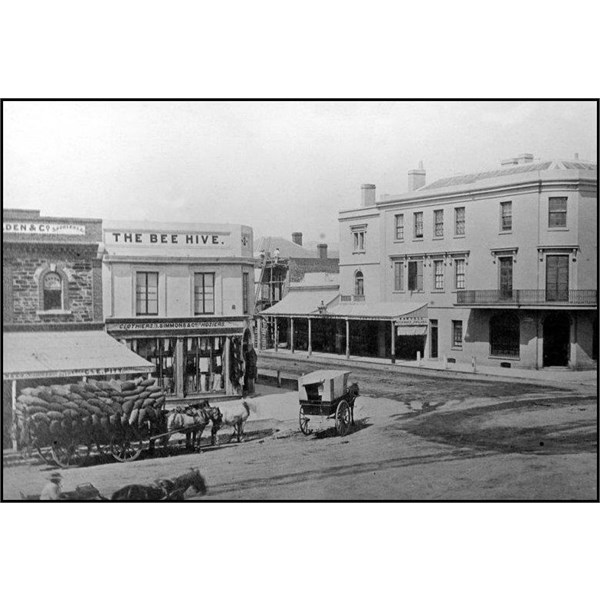
Bee Hive Corner, north east corner of Rundle and King William Streets, c1866

Beehive Corner, Rundle Street looking east from King William Street, c1916
Light’s Plan divided the city into ‘town acres’. By 1840 all but two of the 30 acres that lined Rundle Street had been sold. Seventeen of these acres were preliminary sales made in England prior to colonisation. The remainder were sold at auction in
Adelaide in March 1837. Purchasers included John Morphett (after whom Morphett Street is named) and John Barton Hack (after whom Barton Terrace, North
Adelaide is named), members of the Street Naming Committee. Robert Thomas, who bought two acres, printed the proclamation delivered by Governor Hindmarsh on 28 December 1836 and the first colonial edition of the South Australian Gazette and Colonial Register on 3 June 1837. The Stanhope hand press used by Thomas is in the
heritage collection of History SA.
Of particular note is Quaker Robert Cock, purchaser of acres 80, 83 and 84. Cock arrived on the Buffalo in December 1836 and was appointed as South Australia’s first government auctioneer. He was also a land agent and an explorer of the
Adelaide Hills,
Yorke Peninsula and the eastern coastline of Eyre Peninsula.
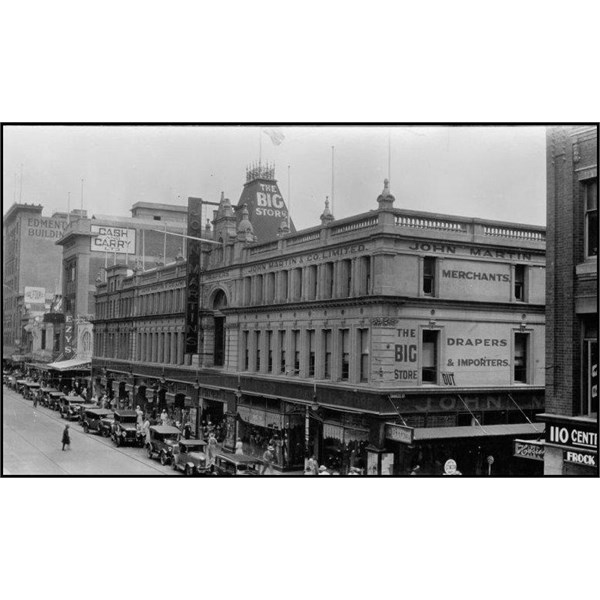
John Martins, west corner of Rundle Street and Charles Street, 1934
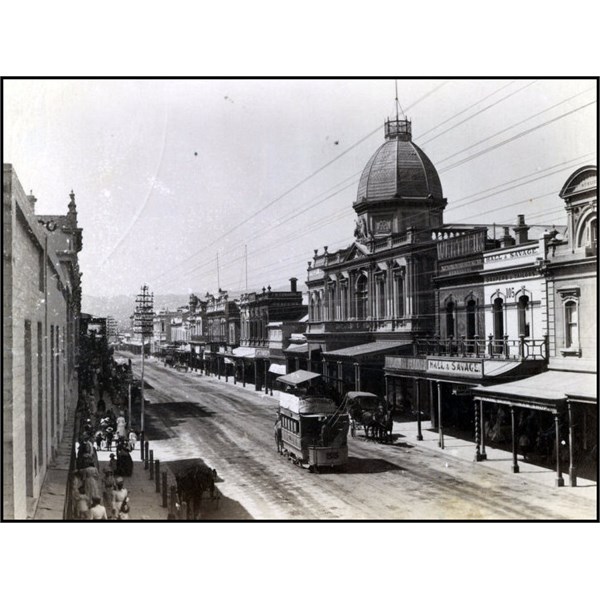
Adelaide Arcade, Rundle Street, looking east from Charles Street, c1888
‘The Big Store’, or ‘Johnnies’ as it came to be known, began in 1866 as a small drapery
shop owned by Peters & Martin at (then) no. 94 Rundle Street west. The successful business rapidly expanded to become John Martin & Co. department store with premises extending to (then) no. 102 on the corner with Charles Street. In 1889 a major building program commenced with the construction of a three-storey left section to the premises. A three-storey right section and central bay, topped with a pediment and tower, were completed in 1898. On 6 April 1901 a fire gutted a large part of the building, which was replaced. Further additions were made to the premises in 1922. The store was refurbished and given a new façade, which became synonymous with the company, in 1936.
(If you were born in
Adelaide or Suburbs as I was in the 1940's then you will have fond memories of John Martins Christmas Magic
Cave , rode the rocking horses Nipper and Nimble and of course made the big important requests to Father Christmas for that dream present)

The Grand Central Hotel, south-east corner of Rundle and Pultney Streets, 1913
Although the name of John Martin continued, the firm became closely associated with the Hayward family. Arthur Dudley Hayward joined the firm in 1876. His son, Edward, joined in 1931 and became a director soon after. It was Edward who initiated the store’s annual Christmas Pageant in 1933. Edward, who became joint managing director with his brother in 1946, was knighted in 1961. He was made chairman of John Martin’s in 1964, overseeing the company’s expansion into the suburbs. He retired in 1980.
Founding partners George Peter Harris and John C Lanyon arrived in
Adelaide on the Candahar on 10 February 1849. By April 1850 they had established a hardware and ironmongery business. Lanyon returned to London in 1855, while Harris continued to run a wholesale ironmongery in
Gawler Place. Additional partners George Scarfe and Richard Smith joined the firm in 1866. In 1884 Harris Scarfe & Co. opened a retail store next to the John Barleycorn Hotel on the south side of Rundle Street west. Harris returned to England in 1873 and died there on 26 November 1873. George Scarfe remained chairman of business until he died on 14 April 1902. The company continued to carry the names of its founders.
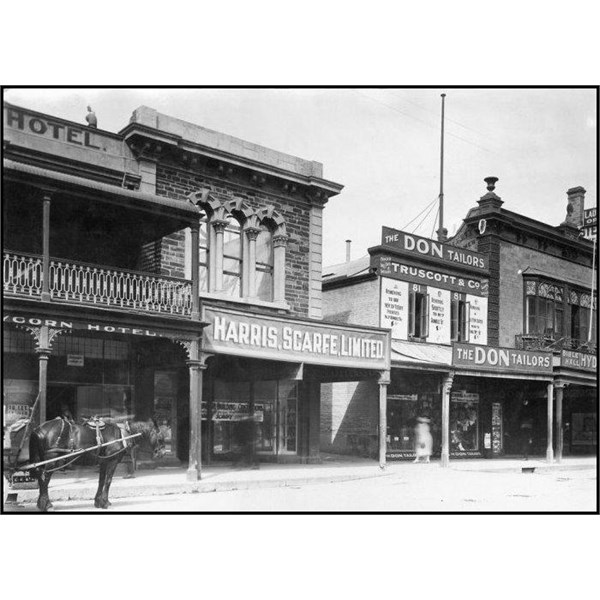
Harris Scarfe Limited, Rundle Street, south side, 1922
The small firm of Harris Scarfe grew to be a major retail and wholesale supplier of household, agricultural and industrial items. Five-storey premises replaced the original Rundle Street
shop in 1923. By 1928 Harris Scarfe occupied premises along part of
Gawler Place and back to
Grenfell Street. In addition to its retail business, Harris Scarfe also manufactured leather goods, including saddlery and luggage. The wholesale business employed a team of commercial travellers in country regions.
In 1971 Harris Scarfe was taken over by the Investment and Merchant Finance Corporation (IMFC). As it continued to grow, the frontage of its Rundle Street store was extended to include a women’s wear department. Charles Davis Ltd acquired control of the business in 1976 and developed the Rundle Mall store as a full department store. In the early 1990s Harris Scarfe expanded to other locations and became Australia’s third largest department store retailer. The firm’s long period of growth ended in collapse in 2001. However, it was revitalised by a consortium and in March 2013 opened a new fashion and homeware store with Rundle Mall and
Grenfell Street frontages.
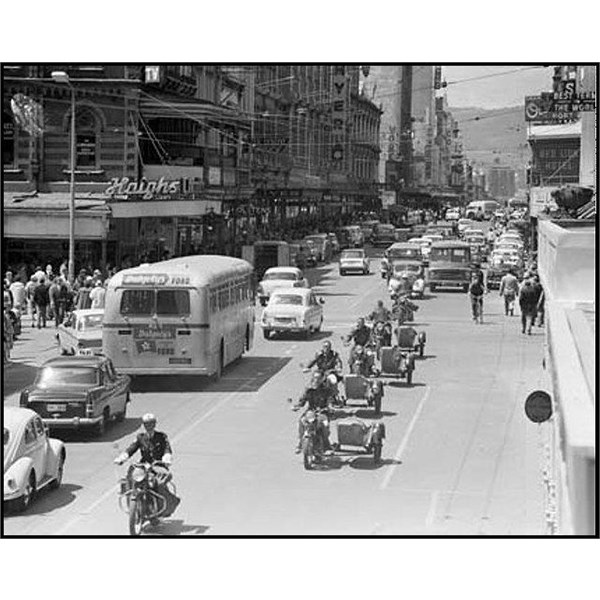
Looking East along Rundle Street, Adelaide 1960
The Rundle Street premises were extended to North Terrace in 1962 and a car
park was added in 1968. Competition in the retail sector led to a takeover by David Jones in 1985. The iconic Rundle Street store closed on 15 March 1998 and was demolished soon after. It was replaced in August 2000 by
Adelaide Central Plaza, housing a new David Jones store and other retailers.
Major changes occurred along Rundle Street in the 1960s and 1970s. Many of the old shops, hotels and theatres disappeared, to be replaced by new roads, car parks and revamped stores as the
Adelaide City Council and businesses set out to modernise the city. On Rundle Street east the Tavistock Hotel was demolished as Frome Street was created out of small, previously unconnected side streets in 1962. Nearer to King William Street, the
York Theatre was razed as part of the widening of
Gawler Place in 1961. Other theatres closed as competition from suburban picture theatres and television reduced attendances.
The differing characters of the western and eastern sections of the street were reinforced in the 1970s with the creation of Rundle Mall. The mall was initiated in November 1972 when Premier Don Dunstan proposed the closure of Rundle Street from King William Street to Pulteney Street. After much, sometimes bitter, debate construction commenced in 1975 to the design of Ian Hannaford Architects. The mall was officially opened on 1 September 1976.

Pedestrian mall in Rundle Street, Adelaide 1976
The making of Rundle Mall stimulated further department store development and the reinvigoration of shopping in the heart of the city. John Martin’s extended its store. Myers and David Jones also revamped their premises. The
Adelaide City Council worked to attract people into the mall with the installation of major works of art. The stainless steel Spheres (popularly known as the ‘Mall’s Balls’ or ‘Bert’s Balls’) were designed by sculptor Bert Flugelman (1923–2013) and installed on 5 October 1977. The Slide, a bronze sculpture of a girl on a slide, was created by John Dowie and gifted to the City of
Adelaide by the John Martin’s board. It was formally presented by Sir Edward Hayward to the Lord Mayor in 1977.
.